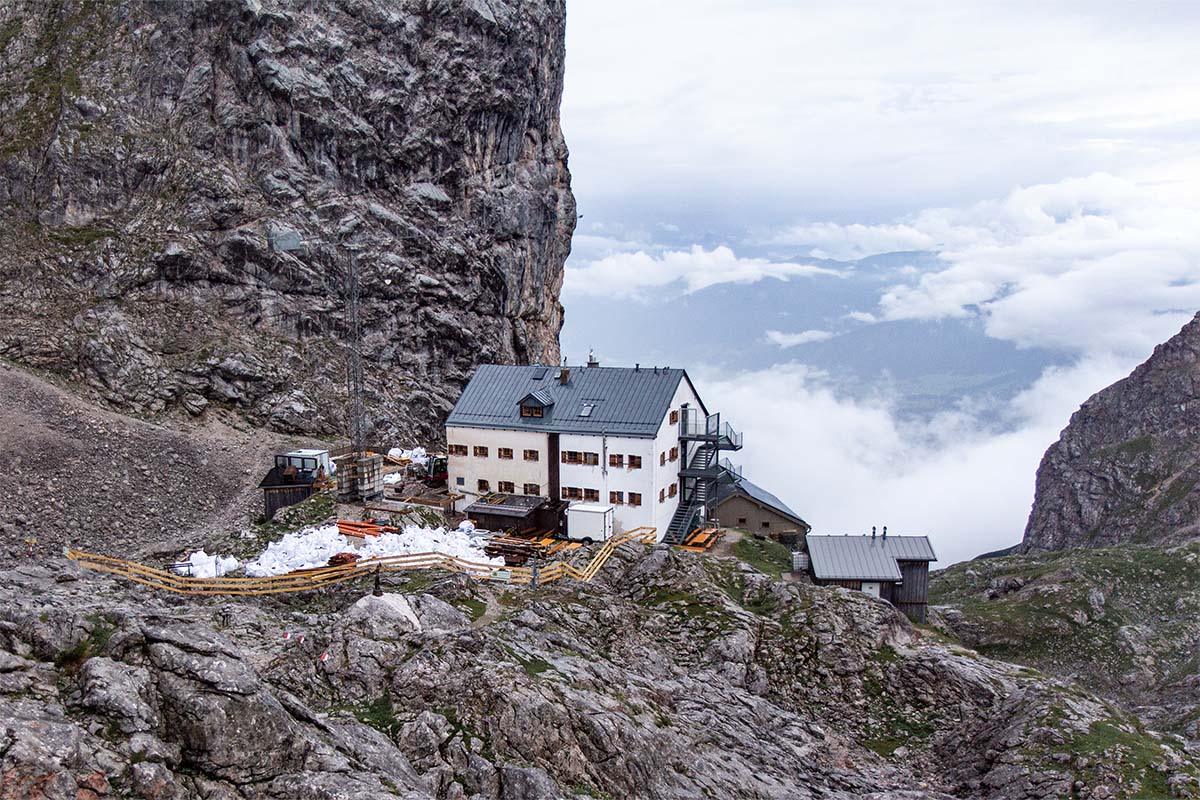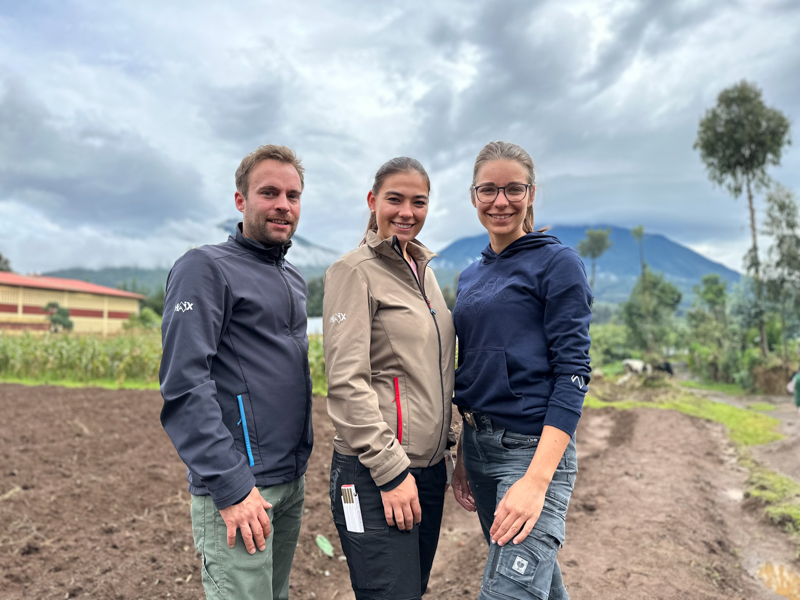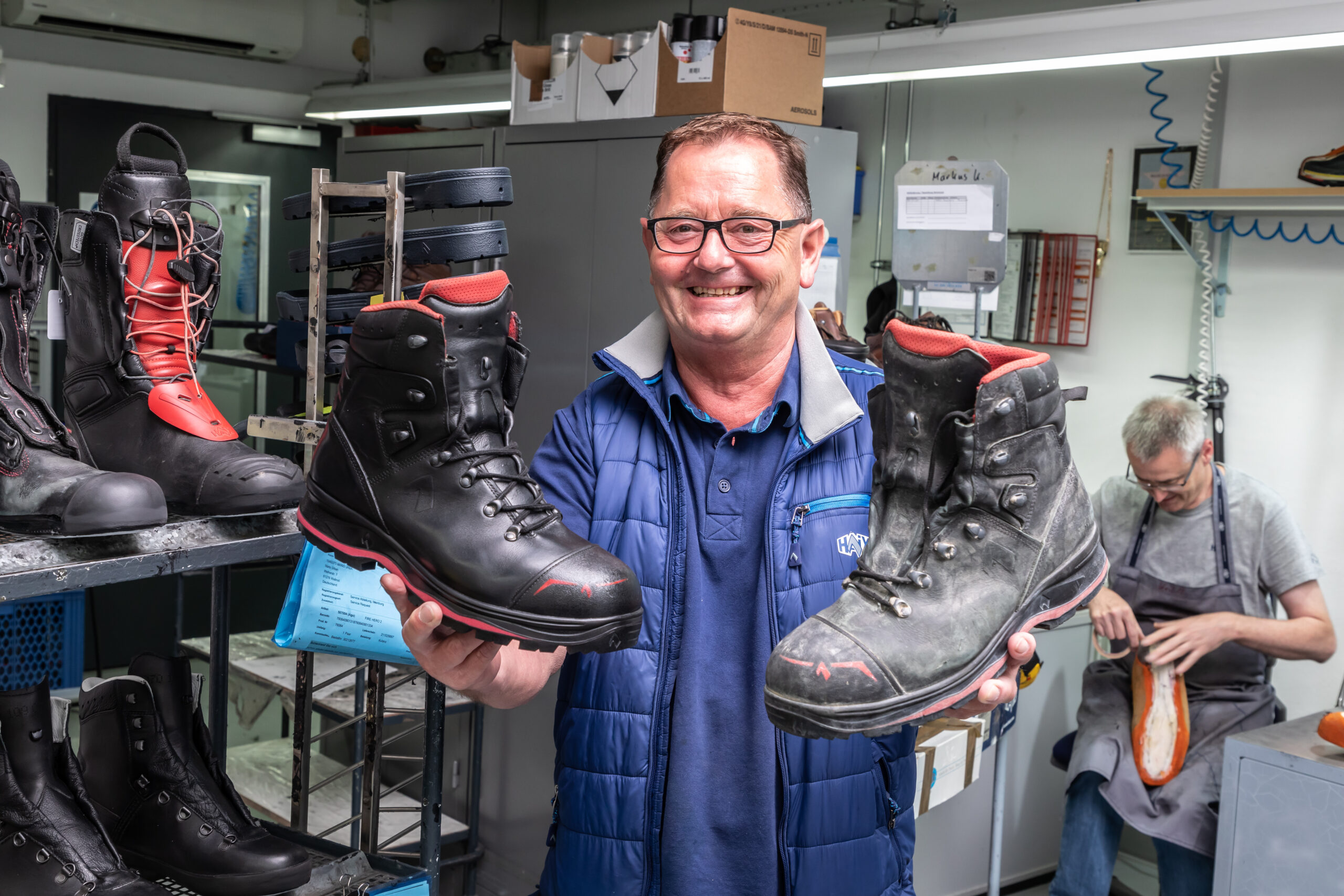Rebuilding of the Riemannhaus in the Steinernes Meer
The paths leading up to Riemannhaus in the Alps are steep. Innkeeper Tanja Strobel told us how her mountain inn is being converted, anyway, complete with crane and excavator.
As soon as we set off along the forest path behind Maria Alm, the rain began. It hasn’t stopped since, and it’s been hours. Despite a layer of waterproofs, our clothes feel damp against our skin. Another 1,000 meters of altitude until we reach Riemannhaus in the Steinernes Meer plateau. When we get there, a group of laborers is busy working despite the weather. Inside, hikers are warming up with a tea, coffee, or beer. Outside, jackhammers are pounding. Riemannhaus is being converted, and a construction site 2,177 meters above sea level brings some unique challenges with it.
Work at lofty heights
The Riemannhaus mountain inn in the Steinernes Meer opened in 1885. Its very first incarnation could accommodate seven people. Following several expansion and conversion projects, its capacity has been climbing steadily. “Where we’re building right now is where the original house used to be,” explains Tanja Strobel, the leaseholder and innkeeper. The German Alpine Club (DAV) owns the site; its Ingolstadt division manages the house. On this rainy weekend in July, the area is covered in construction material. There is a crane, and the foundations are visible. The new building is set to be completed by 2025, offering more space for hikers and climbers wishing to spend the night. Before the extension began, the DAV reported that the house had 34 private beds and 52 dorm spaces.

A Helicopter, of course
There’s plenty of work left to do before then. From the very first step, construction in such rough terrain is immensely challenging. Some background information: The Steinernes Meer is a large plateau between Saalfelden in Pinzgau and Berchtesgadener Land. Approaching it from Maria Alm, you ascend steep mountain paths; the final section is secured with steel ropes. The valley is framed by the Breithorn range to the left and the Sommerberg to the right. Beyond them, miles and miles of rugged limestone landscape, as far as the eye can see. How would you go about getting an excavator, let alone a crane, to the inn?
With a helicopter, of course. Tanja recalls: “The crane and excavator were flown up in parts.” The building material had to be transported in the same way. “They mix the concrete in the valley, pour it into a bucket and fly it up. It takes 50 seconds and is genuinely impressive.” Afterward, the helicopter does a loop around the inn and returns to the valley. “It takes skill – they have to fly with incredible precision,” the innkeeper says admiringly. The goods cable lift is only rarely needed. But this helicopter system has its disadvantages: “Everything depends on the weather.” And the weather in the Steinernes Meer is not always on their side. Rain and thunderstorms can pass as quickly as they roll in. “The wind is also a determining factor in whether or not the helicopter can take off.” The inn is located in a forest aisle between the Sommerstein and Breithorn mountains, right on the edge between the valley and the high plateau. It’s effectively a wind tunnel. To make matters even more difficult, the pilots are flying under visual flight rules – a tall order when the valley is covered in clouds and fog.

Brawn and grit
The best materials and tools are useless without workers. Construction is physically demanding in the best of conditions; when your commute involves 600 meters of altitude on foot from the cable car, you had better be in great shape. Of course, the laborers don’t have to do the hike every day. “From Monday to Friday, they stay at our inn,” explains Tanja. Unfortunately, there’s no chance of a helicopter trip to start the week: For environmental reasons, its flights are strictly limited.
Up on site, the workers endure the same conditions as hikers, so they need a similar level of equipment. From hot and sunny weeks to days of never-ending rain, they have to be prepared for anything. “That’s just mountain life.”

Scarity at altitude
Tanja, her guests, and the workers all have to struggle with one particularly difficult aspect of said mountain life: water scarcity. Like many inns in the Alps, Riemannhaus does not have running water like the houses in the valley. “Our drinking water mostly comes by helicopter or cable car,” explains the innkeeper. For everything else, melted snow and rainwater are used. “I come here in the spring and connect the roof gutters so we get the melted snow from the roof.” Later in the year, they are completely dependent on rainfalls collected via the roof.
Inside the inn, there are many signs explaining the water situation. Nonetheless, quite a few guests will enjoy a full-body wash in the washroom without making any effort to conserve water. It’s a dilemma. Rainy weather brings water to the inn, but fewer guests come. When the skies are blue and the sun is out, the house is often fully booked – and the water runs out quickly. “I’d prefer sunny days and rainy nights.”

A dream come true
Tanja and her daughter, Hannah, have run the mountain inn for two years. It has been a dream come true for the duo. “I’ve always wanted my own inn,” says Tanja. When her daughter couldn’t quite figure out what to do next after her carpentry apprenticeship, she was quick to suggest her own dream: Why not take over an inn? Hannah offered a compromise: “Sure – if you help me.” The two women did not hesitate any further.
Tanja actually works in the sales department of a large company, but she took a sabbatical for her time at Riemannshaus. After all, living your dream needs to be a priority. “Otherwise, you spend your whole life with this idea in the back of your mind.” Sure, you might fail, but never trying in the first place is a type of failure, too. “It was so much fun, and most of our team members have come back again,” she explains. Former employees who were unable to do a second season still like to visit Riemannshaus. “I am so in love with the place. I always say it’s magical.” Will they continue to lease and run the inn? They certainly plan to keep going for another few years, especially after construction finishes. “But then, you never know what the future holds.” One thing is certain: By 2025, the glow-up of the Riemannhaus will be complete. Hungry hikers and weary wanderers can look forward to warm nights in an even lovelier place.










